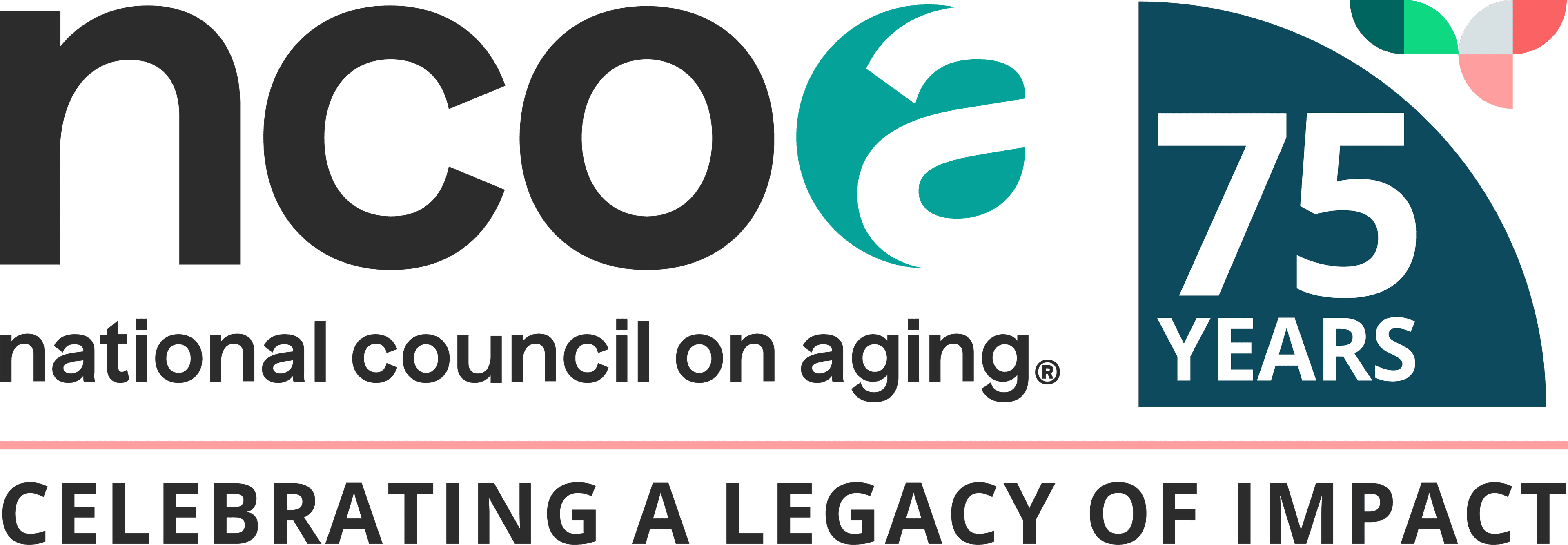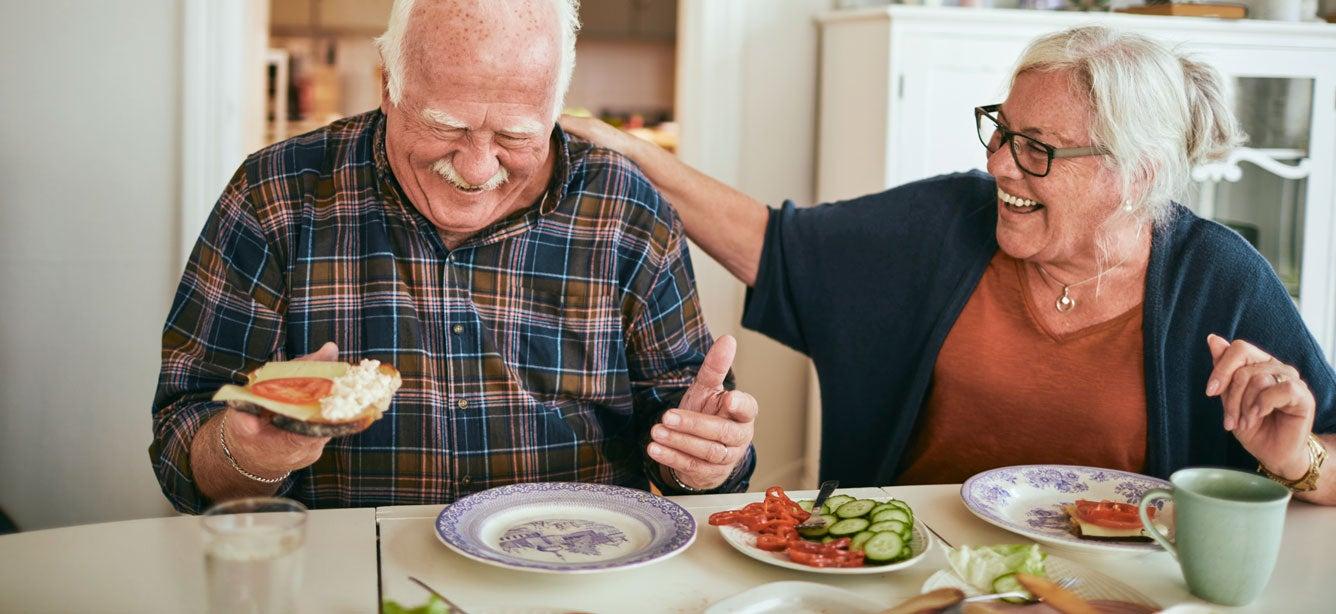
Related Topics
In our later years, good nutrition takes center stage. A healthy diet supports our joints, bones, and muscles and allows us to feel our best and stay active and independent for longer.
The challenge? Aging can bring changes that affect appetite, digestion, and taste perception. If you’re a caregiver, maybe you’ve noticed the person you're caring for is skipping meals or losing weight. Or perhaps they don’t seem to enjoy the foods they once craved.
It’s natural to be concerned about what—and how much—the person you care for is eating. Nearly 1 in 4 adults age 65 and older are malnourished or at risk for malnutrition.1
But the bright side is there are ways you can help them eat better (without adding extra stress to mealtimes). Below are strategies caregivers can use to help older adults get the nourishment they need to age well.
8 tips to help older adults improve their nutrition
1. Create balanced, easy-to-eat meals
Using MyPlate as a guide, start with the basics and build meals that are simple, enjoyable, and well-balanced. Keep portion sizes manageable and make it a point to cover all major food groups:
- Fruits
- Vegetables
- Grains
- Protein foods
- Dairy (and fortified soy alternatives)
Presentation matters, too! A nicely arranged plate bursting with bright colors is enticing to older adults with a reduced appetite. If mobility or coordination is an issue, finger foods or pre-cut items can make eating less frustrating.
For extra variety and to fill nutrient gaps, protein shakes, smoothies, and fortified drinks come in handy. Is the older adult you care for required to limit their salt and sugar intake? Experiment with herbs, spices, citrus juices, and vinegars, which serve as natural flavor enhancers.
2. Focus on nutrient-dense foods
Since calorie needs decrease with age, it’s important for each bite to pack a nutritional punch. Choose foods rich in protein, calcium, fiber, and essential vitamins and minerals—and try to avoid too much added sodium, sugar, and saturated fats.
Some good options include:
- Dark, leafy greens like spinach or kale
- Lean meats (e.g., chicken breast, pork tenderloin)
- Eggs
- Fortified cereals and whole grains
- Dairy products like milk, yogurt, and cheese
- Legumes, nuts, and seeds
Want to boost calorie intake for an older adult without overcrowding their plate? Try incorporating healthy fats like olive oil, avocado, nut butters, or full-fat dairy.
3. Consider oral nutrition supplements
If the person you care for lacks an appetite, or they have a chronic condition that interferes with normal eating, oral nutrition supplements (ONS) are a valuable tool in your nutritional arsenal. These products are available as ready-to-drink beverages, or as a powder to add to meals. Oral nutrition supplements offer convenient, balanced nutrition that can supplement meals or act as a snack or mini-meal. Many oral nutrition supplements in the form of shakes are specially formulated to help fill in micronutrient gaps and meet higher protein or calorie needs. Others may be designed to meet the nutritional needs of older adults with chronic health conditions (e.g., diabetes) that require specialized nutrition support.
Beverage-style oral nutrition supplements are also ideal for older adults who cannot easily chew or swallow food. For an anytime nutrition boost, serve them chilled on their own or add them to a favorite smoothie recipe.
According to Aimee Henrikson, MPH, RD, Senior Manager of Medical Affairs for the BOOST® brand, taste is an important characteristic of an oral nutrition supplement that really impacts whether or not an older adult will consume it to get nutrients they need.
Caregivers are encouraged to try different flavors and look for products their loved one really enjoys,” Henrikson explained.
4. Establish a meal routine
Many older people find comfort in a predictable routine. Consistent meal and snack times can also help regulate their appetite (and make them less likely to forget to eat). Try to schedule meals for your care recipient at the same times each day. Include one or two planned snacks to keep their energy steady.
Whenever possible, make meals a social engagement. Whether they sit down with you or take part in a community meal, eating with others can lift their spirits and stimulate their desire to eat.
5. Offer smaller, frequent meals
Should older adults eat smaller meals? If the person you care for doesn’t have much of an appetite, five to six smaller meals, snacks, or nutritional shakes spaced throughout the day might be a good strategy. Lighter, more frequent eating can help prevent digestive discomfort as well as energy slumps in between meals.
6. Modify food textures
Physical issues—like dental problems, decreased saliva production, and health conditions like stroke or Parkinson’s disease—can affect older adults’ ability to chew and swallow. If this applies to the person in your care, opt for soft-cooked, pureed, or moist foods such as:
- Scrambled eggs
- Yogurt parfaits
- Mashed vegetables
- Stewed meats
- Oatmeal
- Applesauce
- Shakes and smoothies
You can also add gravies, sauces, or broths to help keep foods moist and palatable. If your care recipient is having severe swallowing issues (dysphagia), talk to a speech-language pathologist about creating a safe diet plan tailored to their needs.
7. Respect dietary restrictions and preferences
Be sure to honor the dietary needs and cultural preferences for the person you're caring for. Meals should center around their unique requirements, whether they’re managing heart disease, limiting salt, or avoiding food allergens.
Cultural considerations are important as well. After all, food is not just fuel—it’s a powerful connection to our culture and identity. Familiar and comforting dishes can enhance your care recipient’s appetite, pleasure, and food intake. It also helps them feel seen and respected.
8. Encourage shared decision-making
Older adults often feel like they’re losing their independence and may benefit from participating in mealtime decision-making. Consider giving your care recipient the opportunity to help plan their meals based on appropriate nutrient choices, favorite snack or oral nutrition supplement options, and preferred eating times.
Nutrition tips for success as a caregiver
Improving an older adult’s nutrition goes beyond making careful food choices. It also requires patience, compassion, flexibility, and teamwork.
Below are some tips that can support your efforts as a caregiver:
- Monitor weight and intake: Track any changes in your care recipient’s appetite, food preferences, and weight. Use a simple food journal to help you catch concerns early. This can be a notebook or one of many food journaling apps you can download onto your smartphone.
- Communicate regularly with providers: Talk with the person’s doctor or dietitian about any worries or questions you have. Ask about supplements that might be helpful, food-medication interactions to look out for, and nutrition plans that can help them better manage their chronic health conditions.
- Encourage movement: For some, exercise can help stimulate appetite. Older adults should aim for at least 150 minutes per week of moderate activity. Those with chronic pain or mobility challenges can still benefit from gentle exercises like walking, stretching, and yoga.
- Provide emotional support: “Eating-related changes may feel frustrating or even embarrassing to some older adults,” said Dorothea Vafiadis, MS, Senior Director of NCOA's Center for Healthy Aging. “For caregivers, it’s important to practice patience. Pressuring someone can create stress or even resistance and may actually make them less likely to eat. Taking a gentle, supportive approach helps preserve their dignity and creates a more positive mealtime experience for everyone.”
When it comes to older adults’ nutrition, consistency is key
Whether the person you care for wants to be proactive in healthy aging, or they’re navigating a medical issue, smart dietary habits will set them on the right path. You can help by preparing healthy, thoughtful meals that fit their needs, along with providing plenty of encouragement.
“Those small, steady adjustments can lead to meaningful improvements over time,” Vafiadis said. “Helping someone eat well is one of the simplest, most powerful ways you can support their health and well-being.”
Source
1. Elsa Dent, et al. Malnutrition in older adults. The Lancet. March 18, 2023. Found on the internet at https://pubmed.ncbi.nlm.nih.gov/36716756/





